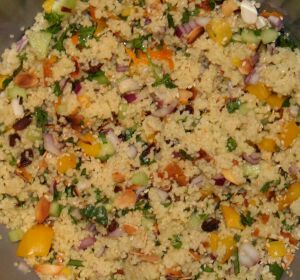Couscous: Difference between revisions
From Cookipedia
No edit summary |
(typo) |
||
| Line 12: | Line 12: | ||
* Add some [[ghee]], [[butter]] or flavoured oil and fluff-up with a fork | * Add some [[ghee]], [[butter]] or flavoured oil and fluff-up with a fork | ||
* Add chopped vegetables / meat / apricots/ sultanas / nuts etc. and serve warm or cold | * Add chopped vegetables / meat / apricots/ sultanas / nuts etc. and serve warm or cold | ||
=See also== | ==See also== | ||
<GoogleBanner>recipe-pages</GoogleBanner> | <GoogleBanner>recipe-pages</GoogleBanner> | ||
* [[Barley Couscous, Beetroot and Feta Salad]] | * [[Barley Couscous, Beetroot and Feta Salad]] | ||
Revision as of 17:36, 28 January 2014

Couscous or kuskus is a pasta from Maghreb of Berber origin. It consists of spherical granules made by rolling and shaping moistened semolina wheat and then coating them with finely ground wheat flour. The finished grains are about 1 mm in diameter before cooking. The Israeli variant is about twice the diameter and made of hard wheat instead of semolina. Traditional couscous requires considerable preparation time and is usually steamed. A more processed quick-cook couscous is what is commonly sold in UK supermarkets and is particularly valued for its short preparation time.
Couscous is traditionally served under a meat or vegetable stew. It can also be eaten alone flavoured or plain, warm or cold, as a dessert or a side dish.
How to cook couscous
- Allow at least about 60 g (2 oz) dried couscous per person for a main course
- Use cooking liquid at one and a half times the volume of the couscous, eg: 1 cup of couscous to 1.5 cups of stock
- For the cooking liquid use soup, stock, water with a stock cube or just lightly salted water
- Bring your liquid to the boil
- Pour over the dried couscous, cover and leave for 10 minutes
- Add some ghee, butter or flavoured oil and fluff-up with a fork
- Add chopped vegetables / meat / apricots/ sultanas / nuts etc. and serve warm or cold
See also
- Barley Couscous, Beetroot and Feta Salad
- Belazu Chicken Couscous
- Broccoli couscous
- Chorizo, orange and apricot couscous
- Chilli chicken with chickpea couscous
- Couscous tabbouleh
- Colourful couscous recipe
- Couscous with eggs and tomatoes
- Couscous, pepper and garlic salad
- Kesksou bil djedj (Couscous with chicken)
- Plain buttered couscous